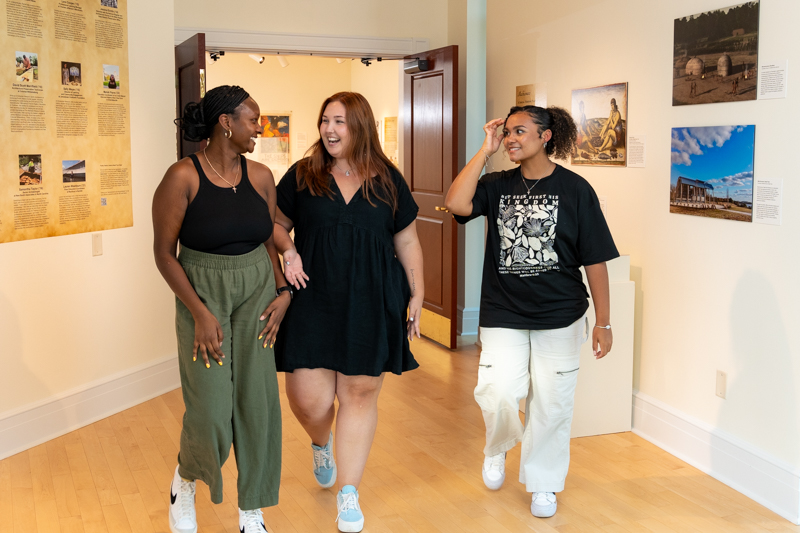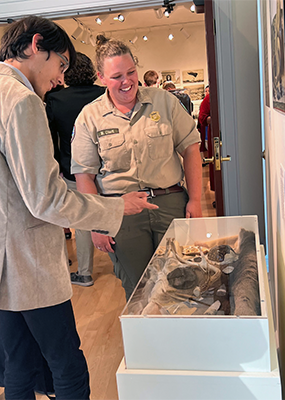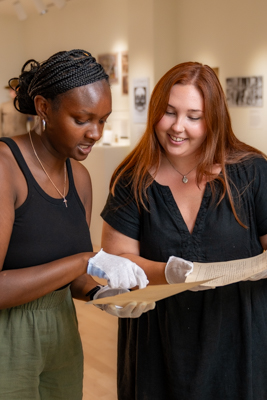
Read time:

A new exhibit at the Mary M. Torggler Fine Arts Center not only digs deep to showcase artifacts Christopher Newport students discovered during community work, it also uncovers bold examples of how such experiential learning leads to success in the workforce.
“Unearthing Hampton Roads: Captains’ Journeys in Public History and Archaeology,” looks at the region’s diverse heritage through the lens of contributions students have made as a result of their internships and service-learning projects at local museums and historic parks.
Its purpose is twofold: to highlight the dynamic history of Hampton Roads and to display the research findings of students’ hands-on work completed during internships in archaeology and public history.
A wide array of interesting items have been uncovered over the past 25 years of CNU’s Archaeology program, including a Colonial mixing bowl unearthed in a Revolutionary War trash pit in James City County; a Colonial key that is thought to have been used in a lock to secure belongings, people or animals; tobacco pipes from the 1700s; and a drinking mug discovered in a Revolutionary War bread oven.
The artifacts, research, and personal stories highlight both the significant research students have done in the field and the ways the projects have in turn had a positive impact on the students who initiated them. The exhibit underscores how the four pillars of a CNU education - undergraduate research, internships, service and study abroad - shape students and their collegiate journeys.
“This exhibit conveys every step of what CNU students can strive to be and what the campus strives for us to be,” said Mazie Clark, ‘22 History, who is one of the students profiled.
“Unearthing Hampton Roads” commemorates the 10-year anniversary of CNU’s Public History Center and the eighth anniversary of the Museum Studies Program. It is a collaborative effort of the Department of History, the Department of Fine Art and Art History, and the Public History Center.
Dr. Michelle Erhardt, Chair of the Fine Art and Art History Department, worked over the summer with Drs. Sheri Shuck-Hall, director of the Public History Center and history internship program, and Andrew Falk, chair of the Department of History, to create the exhibit, weaving together undergraduate research with artifacts from seven Hampton Roads partner institutions: Archaeological and Cultural Solutions, Inc., Machicomoco State Park, The Mariners’ Museum, Watermen’s Museum, Isle of Wight County Museum, Gloucester Museum of History, and the Virginia War Museum. Over the past decade, these institutions have hosted hundreds of Captains as interns, offering unique insight into the professional world of public history and museums.
“Creating an exhibit with our students is a truly magical experience. I love watching them transform ideas into a tangible, curated space and seeing the power of collaboration and creativity in action,” Erhardt said. “Each step, from research to design, brings a new layer of excitement as my students realize their ability to shape how stories are told. The exhibit becomes not just a display, but a shared journey of discovery.”
For Clark, her love of public history began when she was an intern at Machicomoco State Park in Gloucester County, Va. From there, she took part in a project for CNU’s Public History Center, helping to restore the Timberneck House at the park and working with the state Department of Conservation and Recreation. She is now a ranger at Sky Meadows State Park in Delaplane, Va., and most grateful for the experiences CNU provided her.
“CNU gave me the opportunities to excel in everything I held dear and I firmly believe that they strive to do that for every student who walks the Great Lawn,” Clark said.
The exhibit is the melding of past and present, both in terms of students and history. It shows how opportunities CNU provided not only fostered their love of history and community work, but also provided them the tools to make their career goals reality.
“Without that first experience at CNU with the Public History Program and my internships, I may not have found my calling as a ranger of Virginia State Parks,” Clark said.
Clark’s mentor while she was an intern at the state park was Josh Mazzatenta, ‘16 History. Currently the chief ranger at Machicomoco, Mazzatenta is also featured in the exhibit. The theme of students and faculty helping one another reach goals is interlaced throughout the stories on display.
“It’s a full-circle moment here, where you have Captains opening the doors for others,” said Shuck-Hall, also a Professor of History.
She works with students every spring and summer semesters, placing them in public history internships throughout Virginia and beyond. Each student who completes an internship partners with Shuck-Hall to create a virtual exhibit based on their discoveries, many of which appear on the Public History Center’s digital humanities website. “Unearthing Hampton Roads” stems from these student internships and virtual exhibits. Raven Smith, ‘25 Art History, was one of the students who helped construct the exhibit. Being part of it, and seeing first hand all of the success stories, was motivating.

“I feel like I now appreciate 10 times more all the work that goes into creating an exhibit,” she said. “It is an assurance that we can do amazing things in this field.”
The exhibition will be on display until Oct. 20.
Falk explained, “In many ways, this exhibit perfectly encapsulates what we do at the University, which is to bring together our students, faculty, and community partners in meaningful ways.
“It showcases how our students apply their liberal arts education beyond the classroom to uncover and interpret the diverse histories of our community,” he said. “Through experiences like these internships, scores of Captains have deepened their roots in Hampton Roads and also advanced their career plans as public history and museum professionals.”